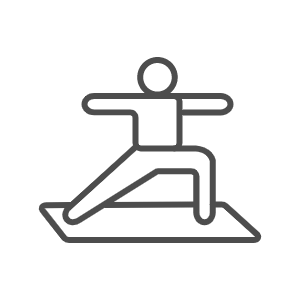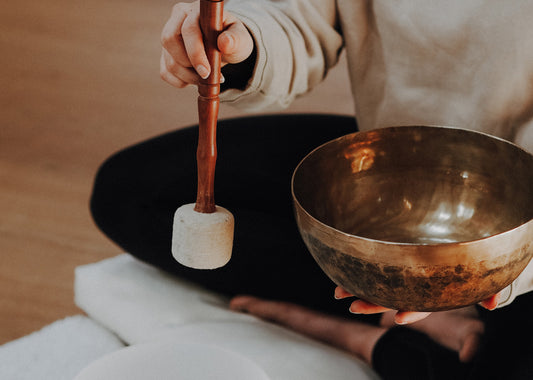
NEW In!
PURE-Matte Light TaupeShopping cart
Your shopping basket is empty
Yoga

Meditation
Sets & Bundles

Yoga offers numerous health benefits, especially when it comes to specifically reducing stress. It is already known that regular yoga practice can help lower blood pressure and heart rate, relax muscles, calm the mind and, most importantly, rebalance and regulate our autonomic nervous system. The combination of physical exercises, breathing techniques and meditation help to relieve stress and discomfort and gives us a holistic framework to find peace again.
The highly complex nervous system in the human body controls basic life-sustaining functions such as breathing, blood circulation, sleep rhythms, digestion and metabolism, but also how we react to the environment and our emotions. Through the nervous system and the sensory organs, people are able to perceive their surroundings and interact accordingly.
In order to create balance, exercise, yoga, meditation and regular relaxation exercises are an effective way to support our nervous system in regulating it.
Yoga practice is particularly exciting for the autonomic nervous system , because here we can influence the interaction between the sympathetic and parasympathetic nervous systems.
The nervous system is structured in different areas:
• central nervesystem
• Peripheral nervous system
The central nervous system (CNS) consists of the brain and spinal cord and helps us feel, think and remember, while the peripheral nervous system (PNS) includes all other nerve fibers in the body that supply the brain and spinal cord with information from the environment and the body take care of.
A subcomponent of the PNS is the autonomic (autonomic) nervous system, which involuntarily controls our internal organs and regulates things like heart rate, blood flow, breathing and digestion. The autonomic nervous system itself has two departments of its own that work together in an interplay of tension and relaxation .
The sympathetic nervous system is responsible for activating the organism when we are in danger or have to cope with a stressful situation (fight or flight). Nutrients and oxygen are made available to the body more quickly and resources are consumed so that we can cope with the dangerous or stressful situation in the best possible way. This can e.g. B. expressed through an increased heart rate, breathing becomes shallower, the muscles tense, etc.
The parasympathetic nervous system, on the other hand, ensures relaxation and recovery , but above all resource building and regeneration after activation of the sympathetic nervous system, meaning that the body's functions are shut down again and the body can recover from the stress it has experienced. Many important functions of the body (detoxification, cell renewal, digestion, etc.) are only possible in a rest mode .
For general health and mental well-being, it is very important that these two counterparts are in balance and that the interaction between motivation and recovery is in balance.
Stress or a period of increased willingness to perform is not bad or should be avoided, because we need the activity in order to actively shape our everyday life and our lives.
We all have stressful phases in our lives in which we are under pressure, perhaps have to achieve a lot or other challenges demand a lot from us. A well-functioning nervous system is a very important factor in how easily and flexibly we can adapt to external circumstances without burning out.
You can easily integrate these yoga exercises into your everyday life:
Whether it's classic Hatha yoga or gentle Yin yoga units, exercise in any form helps the nervous system activate certain regulatory functions and let go of the accumulated stress in the body. This should be practiced regularly or daily in order to bring the nervous system and the stress reaction back into balance in the long term.
- Moving cat-cow: Mobilizes the spine and relieves tension in the back
- The Camel: When we are stressed and tense, we tend to hunch our shoulders or slump our shoulders forward. The camel opens the chest and also gives the breathing spaces more space.
- The fish: Also opens the chest, breathing can be deepened and tension in the shoulders and neck can be relieved. The fish can be very beneficial when supported with a yoga bolster.
- Gentle forward bends: When sitting or standing forward bends, the back of the body and the fascia are stretched and tension is reduced.
During yogic full breathing, you breathe in and out of the 3 breathing spaces in your body one after the other. The deep and conscious inhalation and exhalation helps the muscles to relax more quickly and at the same time the parasympathetic nervous system is stimulated . You can practice full yoga breathing at the beginning and end of every relaxation or yoga session or in everyday life to recover after stressful situations.
Once you have explored the breathing spaces, you can now connect them.
Breathe in one flowing breath into your stomach, into your chest all the way up to the tips of your lungs and exhale empty your lungs, chest and stomach. The breathing movement here should feel like a kind of wave . Repeat 3-5 times as needed.
Yoga is all about calming our wandering minds and practicing moving through life with more awareness and mindfulness . Observe in your everyday life which situations stress you emotionally and physically or whether you unconsciously hold tension in your body, often clench your jaw muscles or whether your breathing is rather shallow. Give yourself short moments throughout the day to check in with yourself and observe how you are doing.
Practices such as yoga nidra , meditation or sound yoga can be valuable helpers to promote greater body awareness, relaxation and mental clarity. Above all, these practices ensure that you find peace again from the inside out and support your nervous system in regulating stress.

Sound healing work is becoming increasingly popular and more and more people are being accompanied into a state of relaxation and holistic well-be...
Continue reading
What is Journaling? Journaling is about gaining access to your own thoughts and feelings by using different writing methods and putting your i...
Continue reading